13 Horrifying Things Living in Your Garbage Disposal (Check #9 ASAP!)
Your kitchen’s garbage disposal isn’t just a convenient way to handle food waste—it’s potentially harboring dangerous microscopic squatters you’d rather not know about.
Behind those grinding blades and beneath that protective rubber guard, colonies of bacteria, mold, and other harmful organisms are setting up camp in your sink’s dark, moist environment.
While you’re going about your daily routine, these unwanted residents multiply rapidly, creating toxic environments that can affect your family’s health.
Before you dismiss these concerns, you’ll want to discover what’s really lurking in your disposal, especially the alarming issue we’ve uncovered at #9.
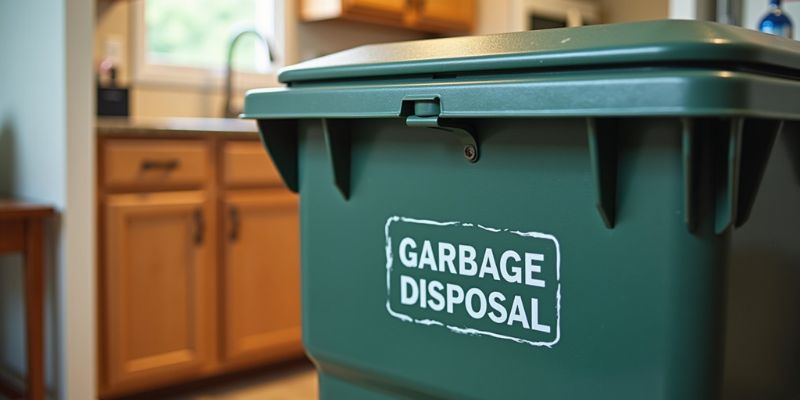
Antibiotic-Resistant Bacterial Colonies
Countless dangerous bacteria thrive in your garbage disposal’s moist, nutrient-rich environment, with some strains evolving to resist common antibiotics.
These resilient microorganisms multiply rapidly, especially when food particles remain trapped in the disposal’s crevices and rubber flaps.
You’re particularly at risk when splashing water sends these bacteria onto nearby surfaces where you prepare food.
To combat these stubborn colonies, you’ll need more than standard cleaning methods.
Run a mixture of ice and rock salt through your disposal weekly to scrub the blades and walls.
Follow up with a solution of vinegar and baking soda, letting it sit for 10 minutes before flushing with hot water.
For maximum protection, spray the rubber splash guard with a natural antimicrobial solution like tea tree oil mixed with water every few days.
Black Mold Breeding Grounds

Hidden beneath your disposal’s rubber splash guard, toxic black mold colonies often establish themselves in the damp, dark environment.
These dangerous fungi thrive on food particles and moisture, releasing harmful spores that can trigger respiratory issues, headaches, and chronic fatigue.
Your disposal’s constant dampness and trapped organic matter create perfect conditions for black mold to flourish.
To protect your family’s health, lift the rubber guard weekly and inspect for dark patches or fuzzy growth.
If you spot mold, create a solution of equal parts white vinegar and water, spray thoroughly, and scrub with a designated brush.
Follow up by running ice cubes and citrus peels through the disposal.
For prevention, regularly clean the splash guard, run cold water for 30 seconds after each use, and keep the unit as dry as possible between uses.
Flesh-Eating Bacteria
While black mold poses serious health risks, an even more aggressive threat lurks in your garbage disposal: necrotizing bacteria, commonly known as flesh-eating bacteria.
These dangerous microorganisms thrive in the warm, moist environment of your disposal, feeding on food particles and organic matter that collect in the unit’s crevices.
You’re at risk when you reach into your disposal, as these bacteria can enter through small cuts or scrapes on your hands.
They quickly multiply and destroy surrounding tissue, leading to severe infections that require immediate medical attention.
To protect yourself, never stick your hands into the disposal, use tongs or pliers to retrieve dropped items, and regularly disinfect the unit with a mixture of hot water and vinegar.
Run ice cubes through monthly to scrape away buildup where bacteria hide.
Salmonella Growth Hotspots
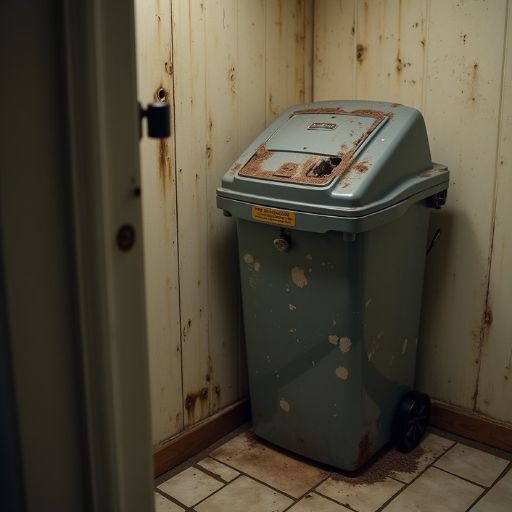
Deep within your garbage disposal‘s rubber splash guard and drain walls, Salmonella bacteria establish thriving colonies that can contaminate your entire kitchen workspace.
These dangerous pathogens multiply rapidly in the moist, food-rich environment, especially when raw meat particles and egg residue collect in hard-to-reach crevices.
You’ll find Salmonella’s favorite breeding spots under the rubber flaps of your disposal’s splash guard and along the grooved interior walls.
Don’t let these bacteria take control of your kitchen.
Run hot water and dish soap through your disposal daily, and regularly clean the rubber guard by lifting its flaps and scrubbing with a designated brush.
For a thorough cleaning, create a natural disinfectant by grinding ice cubes with salt and lemon peels – this combo helps dislodge buildup while killing harmful bacteria.
E. Coli Contamination Zones
Dangerous E. coli bacteria lurk in specific zones of your garbage disposal, often coexisting with Salmonella in the same damp, organic-rich environments.
The highest concentration of E. coli thrives in the splash guard‘s underside and around the grinding chamber’s upper rim, where food particles frequently accumulate.
You’ll find these bacterial colonies multiplying rapidly in areas where meat juices and raw vegetable matter collect, particularly in the crevices between the impeller blades and baffle walls.
Don’t let these contamination zones persist – they’re completely preventable.
Run your disposal with hot water for 30 seconds before and after use, and regularly clean the splash guard by lifting it and scrubbing with a disposal-safe brush.
For deep cleaning, combine ice, salt, and lemon peels monthly to scour these problem areas and maintain a safer kitchen environment.
Disease-Carrying Drain Flies
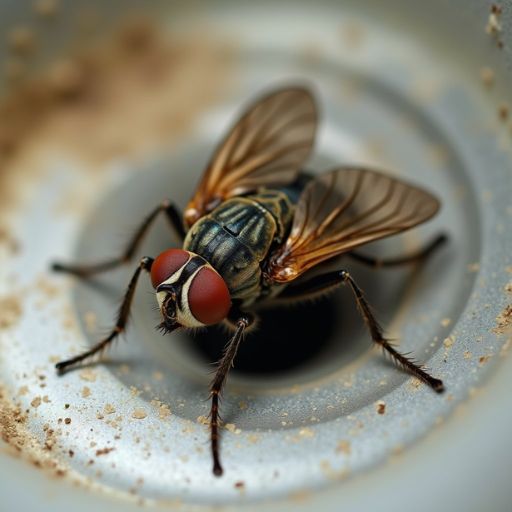
Those tiny, moth-like flies hovering around your garbage disposal aren’t just a nuisance – they’re potential disease vectors that breed in the organic slime coating your drain walls.
These drain flies can carry dangerous bacteria from decomposing waste directly to your kitchen counters and food prep areas.
You’ll need to eliminate their breeding grounds to get rid of them permanently.
Start by cleaning your disposal with a natural mixture of baking soda and vinegar, followed by boiling water.
Next, use a drain brush to scrub away the biofilm where they lay their eggs.
For stubborn infestations, an enzymatic drain cleaner will break down the organic matter they feed on.
Don’t forget to seal off overflow holes and keep your disposal running regularly to prevent future colonies from establishing themselves.
Toxic Biofilm Buildup
The invisible menace lurking inside your garbage disposal isn’t just food debris – it’s a complex ecosystem of bacteria, fungi, and other microorganisms that form a slimy, toxic biofilm coating.
This biofilm doesn’t just smell bad; it’s actually releasing harmful compounds into your kitchen air every time you run the disposal.
As organic matter decomposes within the biofilm layer, it creates perfect conditions for dangerous pathogens like E. coli and Salmonella to thrive.
You’ll need more than just running water to tackle this problem.
Pour a mixture of baking soda and vinegar down the disposal, let it sit for 10 minutes, then flush with hot water.
Follow up with ice and salt to scrub away remaining biofilm.
For stubborn buildup, use an enzymatic cleaner designed specifically for garbage disposals.
Dangerous Food-Borne Pathogens
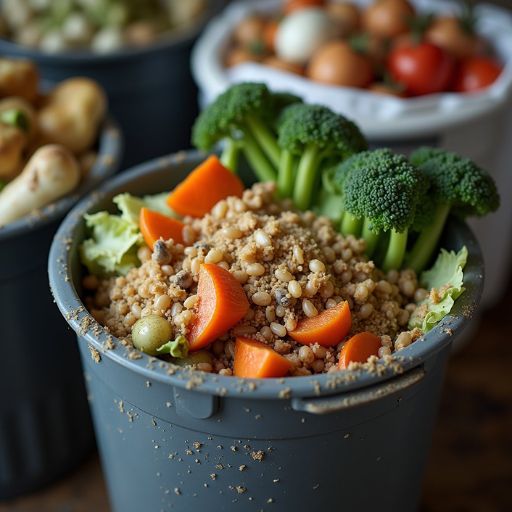
When raw meat, poultry, and seafood scraps make their way into your garbage disposal, they create an ideal breeding ground for potentially lethal pathogens like Listeria monocytogenes, Campylobacter, and Clostridium botulinum.
These dangerous bacteria thrive in the warm, moist environment of your disposal unit, multiplying rapidly even after you’ve run the disposal.
You’ll need to take immediate action to protect yourself and your family.
Run hot water for 30 seconds before and after each use, and regularly disinfect your disposal with a mixture of ice, salt, and lemon peels.
Don’t dispose of raw animal products in your unit – wrap them in paper and place them directly in your outside trash.
If you notice foul odors or slow drainage, you might already have a pathogen problem requiring professional intervention.
Deadly Methane Gas Pockets
Dangerous methane gas can silently accumulate in your garbage disposal’s plumbing system, creating potentially explosive pockets that pose serious risks to your home’s safety.
When food waste decomposes in trapped areas of your pipes, bacteria produce this odorless but highly flammable gas.
You’ll want to watch for warning signs like gurgling sounds, slow drains, or unexplained sewage odors.
Don’t ignore these red flags.
Instead, take immediate action by running cold water for 30 seconds before and after disposal use to flush waste completely through your pipes.
Monthly maintenance with enzyme-based cleaners will break down organic buildup that leads to methane formation.
If you suspect significant gas buildup, don’t attempt fixes yourself.
Call a licensed plumber who can properly vent your system and check for dangerous blockages that could trap methane.
Kitchen Sink Sewage Backflow
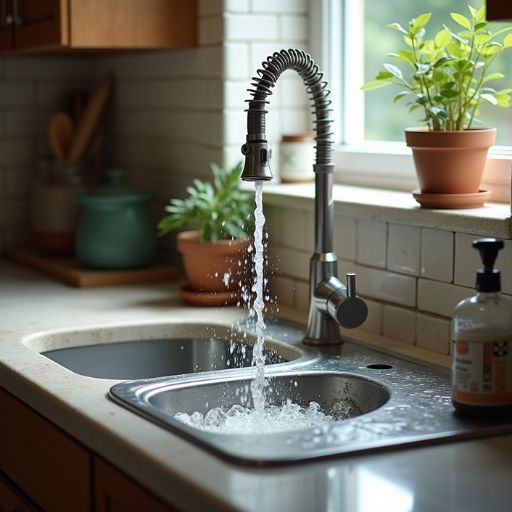
Occasionally, sewage backflow through your kitchen sink can create one of the most unsanitary and hazardous situations in your home’s plumbing system.
When your main sewer line becomes blocked, contaminated water can force its way back up through your disposal, bringing dangerous bacteria, pathogens, and raw sewage into your kitchen.
You’ll notice warning signs like gurgling sounds, slow drainage, or multiple drains backing up simultaneously.
Don’t ignore these red flags – they’re telling you that sewage could soon overflow into your food preparation area.
Install a backwater valve to prevent this health hazard, and keep your disposal system clear of grease, large food particles, and non-biodegradable materials.
If you spot early signs of backflow, contact a licensed plumber immediately to clear your main line before the situation becomes critical.
Cross-Contamination Breeding Sites
Your garbage disposal can harbor multiple breeding sites for harmful bacteria, creating dangerous cross-contamination zones that affect your entire kitchen.
Food particles trapped between the grinding chamber and rubber splash guard become perfect homes for E. coli, salmonella, and other dangerous pathogens.
These bacteria don’t stay put – they spread to your sink basin, countertops, and kitchen tools through water splashes and handling.
Each time you run your disposal, contaminated water droplets can spray up to three feet away, landing on nearby dishes and food prep areas.
The rubber splash guard’s underside is especially problematic, as its dark, moist environment allows bacteria to multiply rapidly.
To break this contamination cycle, clean your disposal weekly with a specialized brush, natural disinfectants, and ice treatment to scrub away breeding sites.
Rotting Food Microorganisms

Inside the damp confines of an uncleaned disposal, various microorganisms thrive on decomposing food scraps, creating hazardous colonies of mold, fungi, and bacteria.
These microscopic invaders multiply rapidly, feeding on trapped organic matter and producing potentially toxic byproducts that can drift up through your sink.
You’ll find dangerous strains like E. coli, Salmonella, and Listeria flourishing in the moist environment, especially if you’ve disposed of raw meat or dairy products.
Black mold can also take hold, releasing spores that trigger respiratory issues and allergic reactions.
To regain control, run your disposal daily, flush it with hot water, and grind ice cubes with salt monthly to scrape away buildup.
You can also use natural cleaners like citrus peels and baking soda to eliminate odor-causing bacteria without harsh chemicals.
Harmful Fungal Colonies
Between the rubber gasket and metal components of your disposal, dangerous fungal colonies establish strongholds that can compromise both the appliance and your health.
Black mold and other toxic fungi thrive in this dark, moist environment, releasing harmful spores that can trigger respiratory issues and allergic reactions when they become airborne during disposal operation.
You’ll need to take immediate action if you spot fuzzy growths or detect a musty odor.
Mix a solution of one part white vinegar with one part baking soda, then pour it down the disposal. Let it sit for 15 minutes before flushing with hot water.
For preventive maintenance, clean your disposal’s rubber gasket weekly using a stiff brush and an anti-fungal cleaner.
Keep the unit dry between uses by running it briefly after washing dishes to eliminate excess moisture.
FAQs
Can a Garbage Disposal Break From Running It Without Water?
Yes, you’ll damage your disposal if you run it without water. The motor can overheat, blades can dull, and parts can seize up. Always run cold water before, during, and after using your disposal.
How Long Should You Wait Before Plunging a Garbage Disposal?
You’ll want to wait at least 15-20 minutes before plunging a jammed disposal. This gives the motor time to cool down and reset its internal breaker, preventing potential damage during the unclogging process.
Why Does My Garbage Disposal Smell Like Rotten Eggs?
Your garbage disposal’s rotten egg smell is likely due to trapped food particles creating hydrogen sulfide gas. You’ll need to clean it thoroughly by running ice, baking soda, and citrus peels to eliminate the odor.
Is It Normal for Garbage Disposals to Make Grinding Metal Sounds?
Hold your horses – metal grinding sounds aren’t normal for your disposal. You’re likely dealing with trapped silverware or damaged components. Turn it off immediately and inspect for foreign objects before calling a plumber.
What’s the Average Lifespan of a Residential Garbage Disposal Unit?
Your garbage disposal should last 8-15 years with proper care. You’ll get more life from your unit if you’re running cold water while using it and avoiding harsh foods like bones or fibrous vegetables.
Final Thoughts
Your garbage disposal isn’t just hiding food scraps—it’s harboring potentially dangerous microorganisms.
Studies show that the average kitchen sink contains over 100,000 bacteria per square inch, making it dirtier than most bathroom surfaces.
Don’t let these hazards persist in your home. Implement a weekly cleaning routine using disposal cleaners, ice, and citrus peels to eliminate harmful bacteria and protect your family’s health.